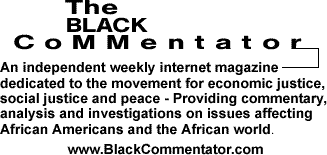
Sarah Kruzan:
When Lady Justice Rewards a Pimp and Punishes His Victim
The Substance of Truth
By Tolu Olorunda
BlackCommentator.com Columnist
I was browsing the web a few days ago when I ran across the following headline: “16yr old gets life in prison for killing her pimp.” Perhaps my considerable awareness of the way the internet works - Shock and Awe = traffic - was what led to initial skepticism; but once I clicked the YouTube video link, all ambiguity vacated.
I
was introduced to the story of Sarah Kruzan,
29, a female inmate in
She
grew up in
The missing “father figure” vacuum in her life was happily filled by G.G. who would take her and her friends skating and to the mall. “G.G. was there at some times,” she says, “and he would talk to me, take me out, and give me all these lavish gifts… and then he would tell me, sex-wise, ‘you don’t need to give it up for free’.” G.G. was a skilled manipulator who knew what he wanted, and just how to get it. When Sarah turned 13, he raped her.
“He uses his manhood to hurt - like break you in,” Sarah recounts. The break-you-in allusion is a mere euphemism for prostitution. At that same age, Sarah was put on the streets, working 12-hour shifts (6P.M.-6.A.M.) for G.G. Sarah saw none of the money she worked for. “Everything was his,” she reports.
Three years later, fed up and frustrated, Sarah snapped and killed G.G., and was subsequently sentenced to life in prison without the possibility of parole. Plus four years.
She recounts the court proceedings: “I remember my lawyer saying that he wanted to ask for me to be sentenced as a Juvenile because Y.A. [California Youth Authority] had found me … susceptible to the treatment; but the judge said that because of my crime - and he said it was well thought-out - that I deserved life without.”
“That means I’m gonna die here,” she heartbreakingly reflects. And with tears soaking up her eyes, admits all wrongdoing: “I definitely know I deserve punishment: I mean, you don’t just take somebody’s life and think that it’s okay; so, yes, definitely, I deserve punishment.” But then she asks, and answers, a question the judge who sentenced her should have pondered more carefully: “How much? I don’t know.”
Even while the possibility of life beyond bars looks gloomy for Sarah, she’s tried to “educate” herself, “reading books,” though admits it’s hard to “excel in prison.”
Perhaps this was what her judge imagined when he condemned her for lack of “moral scruples.” But given the opportunity at a parole hearing, Sarah would like to tell the board: “first of all, I’ve learned what moral scruples are; second, that every day is a challenge … that I’ve found the ability to believe in myself, and that I have a lot of good to offer, now - the person who I am today, at 29: I believe that I could set a positive example. I’m very determined to show that no matter what you’ve done, or where you’ve come from, or what you’ve experienced in life, it’s up to you to change.”
This
is
But there’s another side to it: There’s the pervasive sexism and misogyny of the justice system that fails to receive sufficient address even in the most progressive of circles. While the disproportionate incarceration of Black males is in need of all legal, moral, and financial challenge available, the booming of an incarcerated female population is in dire need of an equally ferocious amount of intervention. For instance, the Women In Prison Project, a non-profit social group, reported in March last year that “[f]rom 1995 to 2006, the number of women inmates in state and federal prisons nationwide increased by 64%.” And that the “growth rate for women in state and federal prisons in 2006 (4.5%) was higher than the average annual rate of growth in each of the previous five years (2.9%).”
In
all the years Sarah Kruzan was being abused,
tortured, manhandled, and molested, it’s hard to imagine no one who mattered
was unaware. But it also has to do with “public attitudes,” as PBS
reported last year in a short e xposé, Fighting Child
Prostitution. Using the
In short, more than a legal matter, it reflects the priorities and presuppositions of a society morally bankrupt. It explains why the 2005 Academy Award for Best Original Song was awarded to “It’s Hard Out Here for a Pimp,” a commercial Rap tale about the hardships of “making change off these women.”
Chances are if G.G. had survived that day, it’s unlikely any charges would have been filed against him for conducting a prostitution ring, or for robbing young girls of their innocence. The more likely outcome is what developed after his death: The transformation of an assailant into a victim, and of a victim into an assailant.
In such a sexually involved case as this, punishing the victim to redeem the assailant is nothing new. The story of Lena Baker, a Black maid denied clemency and afterward executed in 1945 for killing her White male pimp/captor, rips the veil off a society, and its justice system, in bed with Patriarchy. (“What I done, I did in self-defense or I would have been killed myself. Where I was, I could not overcome it.”)
Of course, beyond the criminalization of Youth and the pervasiveness of sexism in the legal system, it also grants evidence to the militarized surrounding enveloping all segments of our lives.
We all know the case of two Pennsylvania judges exposed earlier this year for receiving $2.6 million in kickbacks by sending teenagers to a privately run juvenile detention center - sometimes for crimes such as building spoof MySpace pages to satirize a school principal. But even with the aid of such opportune revelation, mainstream press still fell short of broadening the discourse to include concerns about the school-to-prison pipeline, or the penitentiary privatization schemes that bank on the missteps of human beings.
Acclaimed playwright Wallace Shawn touched on this with grace in his latest text, Essays. [Haymarket Books, 2009, p. 20.] He wrote: “We actually have a large army as well, and a navy and an air force, plus the F.B.I., Coast Guard, Central Intelligence Agency, and marine - oy. It turned out that simply in order to be secure and protect our neighborhood, we needed an empire.”
This is the empire that greed built. And its slaves include anyone as young as 5 and as old as 84.
BlackCommentator.com Columnist, Tolu Olorunda, is a Nigerian native and cultural critic. Click here to reach Mr. Olorunda.


